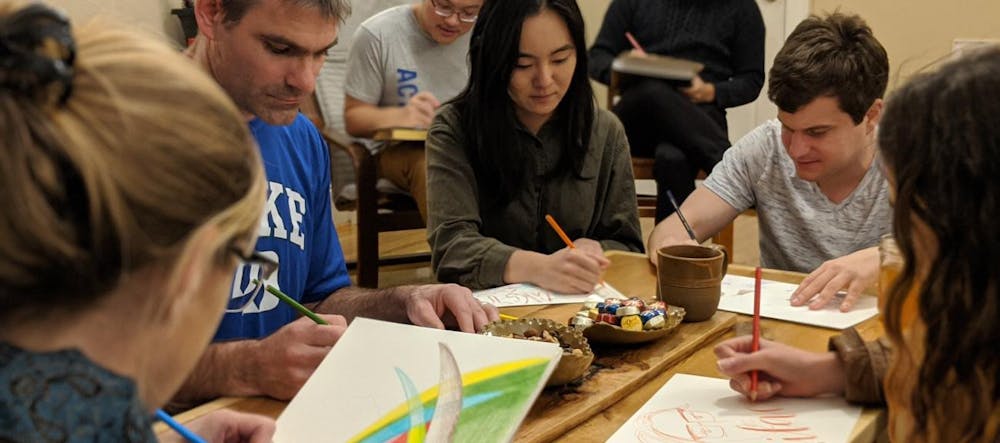Looking at the Wellness Center’s Moments of Mindfulness calendar, I’ll admit I was skeptical.
I am not, in any sense of the word, an art person. My artistic career ended with my mastery of stick figures somewhere around third grade — I never learned to hold a pen correctly, and so anything I attempt to draw usually ends up covered in thick smudges of ink.
I’ve also never been one for self-care. Even my cooler acquaintances, who regularly spend their free time doing things like meditation and bullet journals and cathartic crocheting, didn’t seem to have Moments of Mindfulness on their radar. Most people I had spoken to about it were doubtful: are drum circles and tea tastings really a cure-all for your mental health? (Granted, none of those people had actually been to a Moment of Mindfulness, but I just assumed they knew what they were talking about.)
Another thing about me, though: I am an avowed procrastinator. And Meditative Art, at 7 p.m. on a Tuesday, was the perfect excuse to continue not preparing for my midterms. So I roped two equally studying-averse friends into coming with me as moral support, and off we went.
Although I knew that the Wellness Center existed in theory, I’d never seen it in person until that evening. Room 144, hiding at the end of an inconspicuous corridor, seemed like an odd place to hold an art class; its vinyl dance flooring and walls lined with musical instruments implied a space designed for any other purpose.
Aside from us three, there were only a handful of people sitting at the folding tables scattered throughout the studio, none of whom appeared to be undergraduates. It felt as though we were intruding upon a space that wasn’t ours to join — but it was too late to abandon ship. We sat down and picked up our colored pencils.
The instructor, reading aloud off a preprinted card of instructions, led our group through a guided meditation. Then she explained what we were supposed to be making: the mandala, a concentric circle of shapes that’s been used for millennia as a spiritual symbol (and, nowadays, can be found on a wall hanging in every third college girl’s dorm room).
We drew for the next hour in silence, save for soothing music piped in overhead. At the end of the session, my mandala … didn’t exactly look like a mandala. Its half-finished designs lay several inches off-center, looking more akin to an IKEA plate that’d been dropped onto the floor and haphazardly glued back together than an emblem of hope and healing. But it was mine. And I was strangely proud of it.
As the three of us, mandalas in tow, trudged back through West Campus in the evening rain, we joked about the stress we’d dealt with over the past few days, and the things we were dreading about the week to come. Papers, problem-sets, tests: the first midterm week of fall semester was in full swing, and we all had so much on our respective plates.
But as we later said our goodbyes, I realized: I felt decidedly good, for the first time in a while. How long had it been since I’d actively carved out a guilt-free chunk of my time to do nothing but relax and destress? Days? Weeks? I came back to my dorm, powered through my work as if I was born to do it, passed out, obtained a glorious nine hours of sleep, and aced my exam the next day.
There’s a term that I think describes life at all top universities, but particularly life at Duke, depressingly well: “duck syndrome.” If you embrace both halves of the work-hard-play-hard lifestyle, as many students at Duke do, you’ve probably got a lot in common with the average duck: calm and effortless-looking from the outside, yet paddling furiously under the surface to keep your head above water. Between classes, jobs, and extracurricular commitments, the work just keeps coming and coming—yet we go out with our friends on Friday night, smiling, pretending we aren’t running on the fumes of Thursday’s all-nighter.
This is a problem that’s systemic and deeply rooted—of course sitting at a card table once a week and making art isn’t the solution to all, or even most, of it. But it’s not really about the art. It’s about the shared experience: of coming together as Duke students and declaring that we’re all stressed, that that’s okay, and that setting aside time for ourselves to breathe every once in a while is not a crime.
Point being: I’ve come out of Meditative Art a convert. Come and doodle with me at the Wellness Center next week — I promise your drawing skills will be less cringey than mine.
Get The Chronicle straight to your inbox
Signup for our weekly newsletter. Cancel at any time.
Jules Kourelakos is a Trinity junior and Recess Editor of The Chronicle's 119th volume.

